A
Auto Express
Guest
The electric car is becoming ever-more mainstream, with most manufacturers now offering at least one. And following the recently announced ban on conventional petrol and diesel cars, the number of new EVs available will grow exponentially. So it seems incredible that the first mainstream electric car arrived just a decade ago.
The Nissan Leaf was the first commercially successful mass-produced car designed from the outset to run purely on electricity, and it therefore blazed a trail, even if the earliest cars now seem somewhat outdated in terms of their charging times and range. As such, this pioneering car has become quite uncompetitive in some ways, but don’t write it off too readily, because it can make more sense than you might think.
Models covered
The first-generation Nissan Leaf arrived in the UK in March 2011, a few months after it had made its debut in the US and Japan. All models had an 80kW (107bhp) electric motor and a 24kWh battery pack with just one trim level; these first Leafs were built in Japan and their official range was 109 miles.
In March 2013 a British-built Leaf was introduced and there were now three trim levels (Visia, Acenta and Tekna, with a Visia+ model arriving soon after), a fast-charge (6.6kW) option and a 124-mile range thanks to software tweaks.
In July 2015 a fifth trim level (the Acenta+) appeared, with a standard fast charger. Two months later a 30kWh battery pack became available to increase the range to 155 miles, although the original 24kWh battery was still offered.
Some early Leafs have a leased battery pack; such cars are significantly cheaper to buy because you pay a monthly fee for the battery on top, but they are rare, and it’s possible to pay off the lease so you own the batteries. However, you’ll then be liable for the battery pack in the event of failure.
Initially there was one trim, which came with nav, climate control and 16-inch alloys, but from March 2013 basic Visia had no fast charging (6.6kW) or infotainment screen, so aim for at least a mid-range Acenta model, which got these as standard.

Used Nissan Leaf Mk1 - rear

Used Nissan Leaf Mk1 - dash
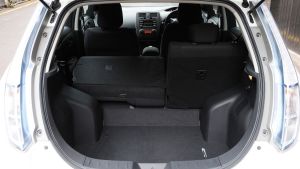
Used Nissan Leaf Mk1 - boot
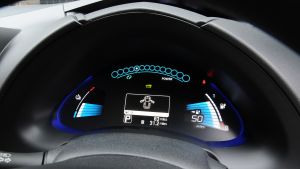
Used Nissan Leaf Mk1 - dials
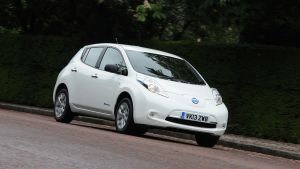
Used Nissan Leaf Mk1 - front action
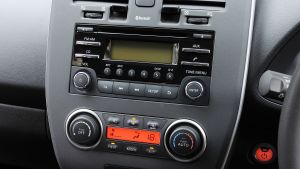
Used Nissan Leaf Mk1 - centre console

Used Nissan Leaf Mk1 - rear seats

Used Nissan Leaf Mk1 - badge
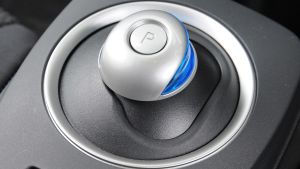
Used Nissan Leaf Mk1 - transmission
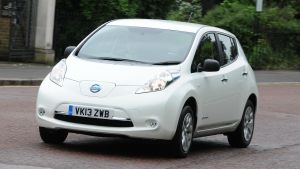
Used Nissan Leaf Mk1 - front
The Visia also came with electric windows front and rear, climate control, power wing mirrors and Bluetooth; the Visia+ added alloys, privacy glass and cruise control. The Acenta came with a rear-view camera plus automatic lights and wipers, while Tekna got leather, 17-inch wheels and a Bose hi-fi, plus heating for the seats and door mirrors.
For years the Leaf had the electric car market to itself, which is why there’s not much else available for the same sort of money as an early example. However, the Renault Zoe is another cracking small hatch that’s very practical, although it is smaller than the Leaf. There are loads to choose from and prices start at just £6,000 or so.
The BMW i3 is a much more premium car with an impressive design, and there are a lot more about than you might think, but prices start at £13,000. The Volkswagen e-Golf is another class act, but few of them are available for less than £20,000. Or for £12,000 you can buy a 2014 Kia Soul EV with a similar tech spec to the Leaf.
Charging cables
Ensure all charging cables are present and undamaged; new ones are costly, but you could consider a used one.
Charge times
It takes eight hours to fully charge a Leaf using a domestic 13-amp three-pin plug socket; the fast charger roughly halves this.
Phone apps
Buy a Leaf with NissanConnect/Carwings (Acenta trim and above), and you can monitor the battery charge remotely from your phone.
Infotainment
The Leaf’s infotainment system uses an SD card. Ensure this is present and correct, because buying a replacement is costly.
With excellent refinement and a cosseting ride, the Leaf is very relaxing to travel in – something that is helped by the electric powertrain being virtually silent, so there’s no engine noise to put up with.

Used Nissan Leaf Mk1 - rear

Used Nissan Leaf Mk1 - dash

Used Nissan Leaf Mk1 - boot

Used Nissan Leaf Mk1 - dials

Used Nissan Leaf Mk1 - front action

Used Nissan Leaf Mk1 - centre console

Used Nissan Leaf Mk1 - rear seats

Used Nissan Leaf Mk1 - badge

Used Nissan Leaf Mk1 - transmission

Used Nissan Leaf Mk1 - front
There’s lots of seat adjustment, but the steering wheel adjusts for rake only, not reach, making it harder to find an ideal driving position. There’s plenty of room for four adults; five fit if absolutely necessary, but it’ll be a bit cramped. The boot is reasonably spacious for a car of this size, and the Leaf can stow an impressive 370 litres with the back seats in place, or 720 litres with them folded – although they don’t go down entirely flat.
Check out the latest used prices for the Nissan Leaf on our sister site Buyacar.
One of the things that buyers were promised with the arrival of electric cars was rock-bottom servicing costs. After all, with no spark plugs, fuel filters, cambelts and so on, an electric car has very few parts that actually need replacing, aside from the brakes.
Despite this, some scheduled maintenance costs for the Leaf – as with many other EVs – are on par with more conventional cars. Crucially, though, as the car’s mileage builds up, the servicing costs don’t shoot up as they often do for those conventional alternatives. So although the Leaf’s maintenance costs can seem surprisingly steep in the short term, those bills shouldn’t increase as the car ages.
The Leaf’s service interval is set at every 12 months or 12,000 miles, with services alternating between minor and major at a cost of £159 and £209 respectively; the latter includes fresh brake fluid, which is required every two years.
The original Leaf has been recalled three times so far, firstly in January 2015 because of faulty steering columns being fitted during the manufacturing process, potentially leading to a loss of steering in the worst-case scenario. The 4,474 Leafs affected by this fault were built between February 2013 and October 2014.
The second recall came in August 2015 and involved 10,248 Leafs made between May 2013 and March 2015. Only cars with keyless go were affected; the switch could remain in the engaged position, leading to the electric motor cutting out entirely. The most recent action was issued in July 2017 and it affected just 65 Leafs made in February and March 2017. These were fitted with a faulty headlamp-levelling system; Nissan’s fix was to update the control unit’s software.
For such an early EV, a 44th place (out of 100) in our 2019 Driver Power used car survey was a good result. The high spots were the Leaf’s acceleration, refinement, running costs and reliability; owners disliked the design, interior quality and much of the driving experience, including the handling. The Nissan also came 33rd out of 75 in our 2017 new car survey, having been 12th in 2016, and eighth in 2015.
For some buyers a Mk1 Leaf will never make sense because of the limited range and slow charging rate, but it’s more usable than you might expect, especially if you do mainly urban journeys. Many people bought a Leaf as a second car only to find that it becomes their first, such is its usability. What puts off some buyers is the worry of the battery pack failing with a hefty bill resulting. But the batteries come with an eight-year warranty, and Nissan claims that failures are virtually unknown. Even so, cells can be replaced for £665 per module (one module contains eight cells; there are 192 cells in total), which helps to cut repair bills. With low running costs, excellent refinement and reliability plus a roomy cabin, there’s plenty to like about the Leaf.
Continue reading...
The Nissan Leaf was the first commercially successful mass-produced car designed from the outset to run purely on electricity, and it therefore blazed a trail, even if the earliest cars now seem somewhat outdated in terms of their charging times and range. As such, this pioneering car has become quite uncompetitive in some ways, but don’t write it off too readily, because it can make more sense than you might think.
Models covered
- Nissan Leaf Mk1 (2011-2017) - It was revolutionary as a new car, and the all-electric Leaf can be a great used buy.
History
The first-generation Nissan Leaf arrived in the UK in March 2011, a few months after it had made its debut in the US and Japan. All models had an 80kW (107bhp) electric motor and a 24kWh battery pack with just one trim level; these first Leafs were built in Japan and their official range was 109 miles.
In March 2013 a British-built Leaf was introduced and there were now three trim levels (Visia, Acenta and Tekna, with a Visia+ model arriving soon after), a fast-charge (6.6kW) option and a 124-mile range thanks to software tweaks.
In July 2015 a fifth trim level (the Acenta+) appeared, with a standard fast charger. Two months later a 30kWh battery pack became available to increase the range to 155 miles, although the original 24kWh battery was still offered.
Which one should I buy?
Some early Leafs have a leased battery pack; such cars are significantly cheaper to buy because you pay a monthly fee for the battery on top, but they are rare, and it’s possible to pay off the lease so you own the batteries. However, you’ll then be liable for the battery pack in the event of failure.
Initially there was one trim, which came with nav, climate control and 16-inch alloys, but from March 2013 basic Visia had no fast charging (6.6kW) or infotainment screen, so aim for at least a mid-range Acenta model, which got these as standard.

Used Nissan Leaf Mk1 - rear

Used Nissan Leaf Mk1 - dash

Used Nissan Leaf Mk1 - boot

Used Nissan Leaf Mk1 - dials

Used Nissan Leaf Mk1 - front action

Used Nissan Leaf Mk1 - centre console

Used Nissan Leaf Mk1 - rear seats

Used Nissan Leaf Mk1 - badge

Used Nissan Leaf Mk1 - transmission

Used Nissan Leaf Mk1 - front
The Visia also came with electric windows front and rear, climate control, power wing mirrors and Bluetooth; the Visia+ added alloys, privacy glass and cruise control. The Acenta came with a rear-view camera plus automatic lights and wipers, while Tekna got leather, 17-inch wheels and a Bose hi-fi, plus heating for the seats and door mirrors.
Alternatives to the Nissan Leaf Mk1
For years the Leaf had the electric car market to itself, which is why there’s not much else available for the same sort of money as an early example. However, the Renault Zoe is another cracking small hatch that’s very practical, although it is smaller than the Leaf. There are loads to choose from and prices start at just £6,000 or so.
The BMW i3 is a much more premium car with an impressive design, and there are a lot more about than you might think, but prices start at £13,000. The Volkswagen e-Golf is another class act, but few of them are available for less than £20,000. Or for £12,000 you can buy a 2014 Kia Soul EV with a similar tech spec to the Leaf.
What to look for
Charging cables
Ensure all charging cables are present and undamaged; new ones are costly, but you could consider a used one.
Charge times
It takes eight hours to fully charge a Leaf using a domestic 13-amp three-pin plug socket; the fast charger roughly halves this.
Phone apps
Buy a Leaf with NissanConnect/Carwings (Acenta trim and above), and you can monitor the battery charge remotely from your phone.
Infotainment
The Leaf’s infotainment system uses an SD card. Ensure this is present and correct, because buying a replacement is costly.
Interior
With excellent refinement and a cosseting ride, the Leaf is very relaxing to travel in – something that is helped by the electric powertrain being virtually silent, so there’s no engine noise to put up with.

Used Nissan Leaf Mk1 - rear

Used Nissan Leaf Mk1 - dash

Used Nissan Leaf Mk1 - boot

Used Nissan Leaf Mk1 - dials

Used Nissan Leaf Mk1 - front action

Used Nissan Leaf Mk1 - centre console

Used Nissan Leaf Mk1 - rear seats

Used Nissan Leaf Mk1 - badge

Used Nissan Leaf Mk1 - transmission

Used Nissan Leaf Mk1 - front
There’s lots of seat adjustment, but the steering wheel adjusts for rake only, not reach, making it harder to find an ideal driving position. There’s plenty of room for four adults; five fit if absolutely necessary, but it’ll be a bit cramped. The boot is reasonably spacious for a car of this size, and the Leaf can stow an impressive 370 litres with the back seats in place, or 720 litres with them folded – although they don’t go down entirely flat.
Prices
Check out the latest used prices for the Nissan Leaf on our sister site Buyacar.
Running costs
One of the things that buyers were promised with the arrival of electric cars was rock-bottom servicing costs. After all, with no spark plugs, fuel filters, cambelts and so on, an electric car has very few parts that actually need replacing, aside from the brakes.
Despite this, some scheduled maintenance costs for the Leaf – as with many other EVs – are on par with more conventional cars. Crucially, though, as the car’s mileage builds up, the servicing costs don’t shoot up as they often do for those conventional alternatives. So although the Leaf’s maintenance costs can seem surprisingly steep in the short term, those bills shouldn’t increase as the car ages.
The Leaf’s service interval is set at every 12 months or 12,000 miles, with services alternating between minor and major at a cost of £159 and £209 respectively; the latter includes fresh brake fluid, which is required every two years.
Recalls
The original Leaf has been recalled three times so far, firstly in January 2015 because of faulty steering columns being fitted during the manufacturing process, potentially leading to a loss of steering in the worst-case scenario. The 4,474 Leafs affected by this fault were built between February 2013 and October 2014.
The second recall came in August 2015 and involved 10,248 Leafs made between May 2013 and March 2015. Only cars with keyless go were affected; the switch could remain in the engaged position, leading to the electric motor cutting out entirely. The most recent action was issued in July 2017 and it affected just 65 Leafs made in February and March 2017. These were fitted with a faulty headlamp-levelling system; Nissan’s fix was to update the control unit’s software.
Driver Power owner satisfaction
For such an early EV, a 44th place (out of 100) in our 2019 Driver Power used car survey was a good result. The high spots were the Leaf’s acceleration, refinement, running costs and reliability; owners disliked the design, interior quality and much of the driving experience, including the handling. The Nissan also came 33rd out of 75 in our 2017 new car survey, having been 12th in 2016, and eighth in 2015.
Verdict
For some buyers a Mk1 Leaf will never make sense because of the limited range and slow charging rate, but it’s more usable than you might expect, especially if you do mainly urban journeys. Many people bought a Leaf as a second car only to find that it becomes their first, such is its usability. What puts off some buyers is the worry of the battery pack failing with a hefty bill resulting. But the batteries come with an eight-year warranty, and Nissan claims that failures are virtually unknown. Even so, cells can be replaced for £665 per module (one module contains eight cells; there are 192 cells in total), which helps to cut repair bills. With low running costs, excellent refinement and reliability plus a roomy cabin, there’s plenty to like about the Leaf.
Continue reading...
